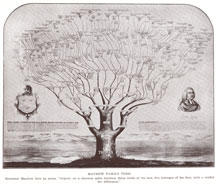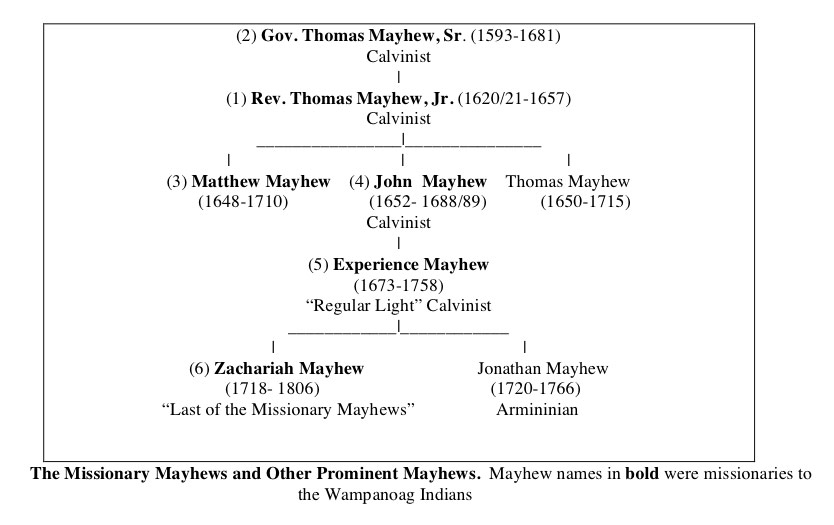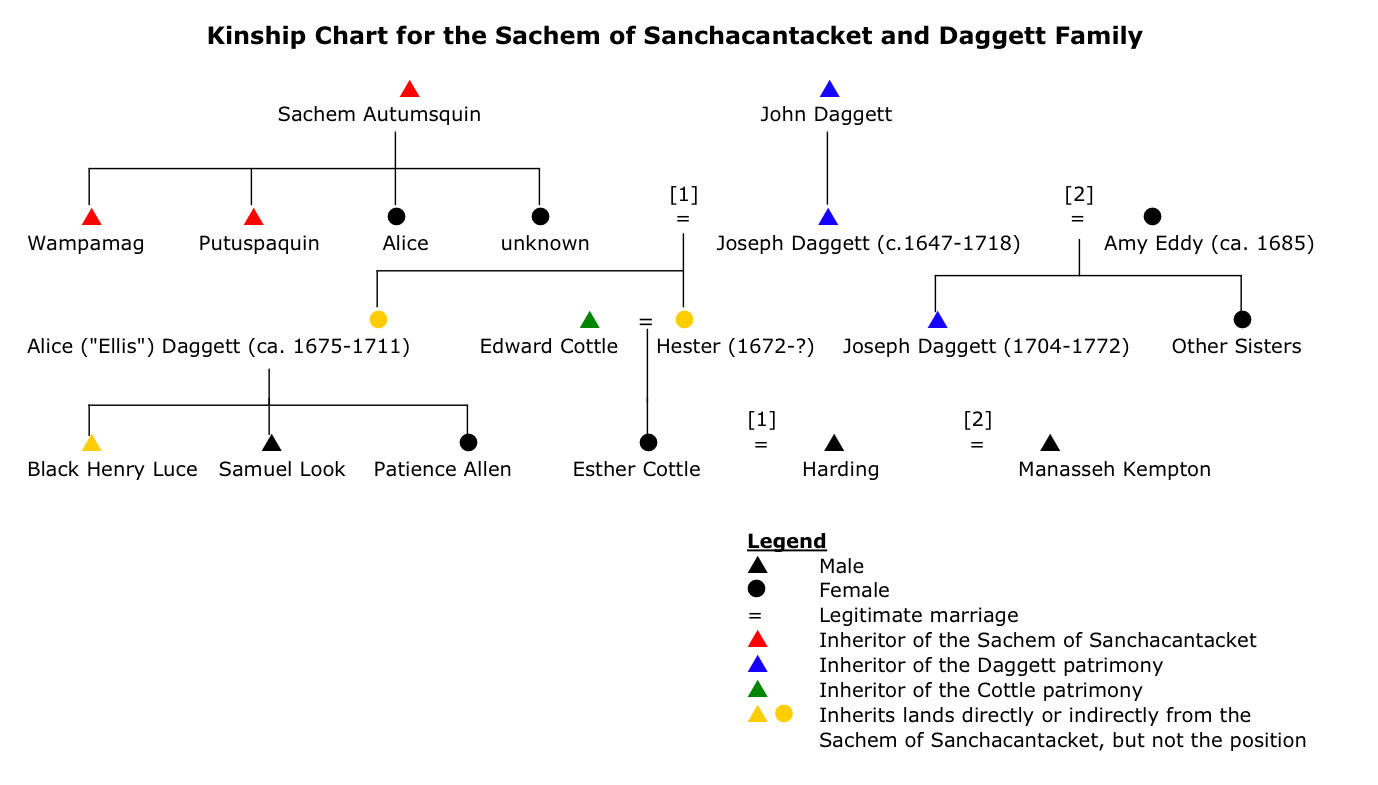Study Guide Social Hierarchies

Table of Contents
Kinship
 Family trees and genealogy are one of the most popular American hobbies today. Although skeptics suggest that this interest is merely a way to compensate for the large physical distances that contemporary American families endure on a regular basis, Americans seem to believe that who their relatives were (and are) is an essential part of their identities. As American cities grew during the nineteenth century and people grew more isolated, professional and homemade genealogies became increasingly in vogue. Example of this craze include (1) the illustrated Mayhew Family Tree (right) from the frontispeice to Hare's biography of Thomas Mayhew, and (2) the genealogies included in the third volume of Edward Banks' History of Martha's Vineyard, some of which is posted online by Martha's Vineyard Historical Society. Family trees like that of the Mayhew clan help distant relatives not only feel physically connected, but also remind descendents of famous ancestors (such as Jonathan Mayhew), and their illustrious origins (as symbolized by the Mayhew coat of arms).
Family trees and genealogy are one of the most popular American hobbies today. Although skeptics suggest that this interest is merely a way to compensate for the large physical distances that contemporary American families endure on a regular basis, Americans seem to believe that who their relatives were (and are) is an essential part of their identities. As American cities grew during the nineteenth century and people grew more isolated, professional and homemade genealogies became increasingly in vogue. Example of this craze include (1) the illustrated Mayhew Family Tree (right) from the frontispeice to Hare's biography of Thomas Mayhew, and (2) the genealogies included in the third volume of Edward Banks' History of Martha's Vineyard, some of which is posted online by Martha's Vineyard Historical Society. Family trees like that of the Mayhew clan help distant relatives not only feel physically connected, but also remind descendents of famous ancestors (such as Jonathan Mayhew), and their illustrious origins (as symbolized by the Mayhew coat of arms).
During the colonial era, kinship was seen as crucial in both Wampanoag and white society. Kinship is defined as the way that a society uses relationships (such as marriage, parentage, and adoption) to create social groups, roles, and categories (Schwimmer). Kin groups determine not only one's lineage, but also "property-owning units, the political units, the religious units" and other key groups that make up a society (Schneider v). Kinship is either traced through "parents and ancestors of only one sex" (unilineal systems) or through either or both parents (cognatic systems) (Schwimmer). Most unilineal systems trace decent through the father (they are "patrilineal").
 Patrilineal descent was incredibly important for both Wampanoags and English colonists. Among New England Algonquians, although some land could be transferred through the female line (matrilineal descent), paternal ties were "far more crucial." For example, sachems usually inherited their office through the paternal line, and the office usually went to a male relative (Plane 21). Even women who inherited the position of squa-sachem did so through their fathers or other male relatives. Patrilineal descent was also crucial for colonists: women took their husband's name upon marriage and in the case of a husband's death, the claims of wives to property were subordinate to that of their children. The power of the father was felt in both religious and political spheres: the "family reproduced patriarchal relations of power in which the obedience of wives, daughters, and children, was thought to be religiously proscribed" (O'Brien 23; Ditz 26). Moreover, since only male Puritans could be ministers, the religious legacy of the "missionary Mayhews" was passed along only through male descendents (left). Wills from Martha's Vineyard reveal although both sons and daughters might inherit something, what they inherited was often unequal. Moreover, only children of legitimate marriages tended to inherit property (and status) from their fathers.
Patrilineal descent was incredibly important for both Wampanoags and English colonists. Among New England Algonquians, although some land could be transferred through the female line (matrilineal descent), paternal ties were "far more crucial." For example, sachems usually inherited their office through the paternal line, and the office usually went to a male relative (Plane 21). Even women who inherited the position of squa-sachem did so through their fathers or other male relatives. Patrilineal descent was also crucial for colonists: women took their husband's name upon marriage and in the case of a husband's death, the claims of wives to property were subordinate to that of their children. The power of the father was felt in both religious and political spheres: the "family reproduced patriarchal relations of power in which the obedience of wives, daughters, and children, was thought to be religiously proscribed" (O'Brien 23; Ditz 26). Moreover, since only male Puritans could be ministers, the religious legacy of the "missionary Mayhews" was passed along only through male descendents (left). Wills from Martha's Vineyard reveal although both sons and daughters might inherit something, what they inherited was often unequal. Moreover, only children of legitimate marriages tended to inherit property (and status) from their fathers.
For Wampanoags, kinship was an important means of cementing political alliances. Sachems regularly ensured support for their regimes by distributing favors and political power to family members, and the often sought marriages for their children that would help ensure military support during times of trouble. Although polygamy and divorce were both acceptable in Wampanoag society, it appears that in order to inherit the position of the sachem, an individual had to be descended from a royal family both on his mother and father's side (Plane 21-23, 50-51).
One of the most interesting examples of a convergence of all of these issues is the Daggett Family (below). The lineage of the Daggett family has been a source of contention, and Catherine Merwin Mayhew (Genealogist of the Martha's Vineyard Historical Society) and Andrew Pierce (author of The Wampanoag Genealogical History of Martha's Vineyard), provide some useful corrections to the information provided in Banks' History of Martha's Vineyard. I have summarized these below in the Kinship Chart for the Sachem of Sanchacantacket and Daggett Family (L. Leibman, 2008). Joseph Daggett (1647-1718) was a white colonist who married at least two times, once to a daughter of the Wampanoag sachem Autumsquin, and once to a white woman, possibly named Amy Eddy (ca. 1668- 1712/14). Joseph Daggett had three children: Hester and Alice ("Ellis") Daggett by his Wampanoag wife, and then a son by his white wife, Joseph Daggett, Jr. (1704-?) as well as several female children, including Elizabeth, Amy, and Temperance, who are mentioned in Joseph's will. Hester (1672-1708?) went on to marry a white colonist named Edward Cottle (1666-1751?), with whom she had at least one daughter who herself married several colonists in succession. In contrast, Alice (ca. 1675-1711) never married, though she had three illegitimate children by three different white colonists. Alice Daggett was taken to court on fornication charges for each of these births, and in response filed suits against the fathers for financial support. As a result, her children each take the names of their fathers, rather than their mother's name: Black Henry Luce (son of "White-eyed Henry Luce"), Samuel Look (son of Samuel Look), and Patience Allen. The wills of Joseph Daggett, Alice (Ellis) Daggett, and Edward Cottle are in the archive and can be usefully compared to see which child inherits what goods and property.
Kinship and inheritance was also important for the Wampanoag side of the family (above in red). The sachem Autumsquin had at least four children: Wampamag ("Mr. Sam, "Samuel"; ?-1689), Alice (married Thomas Tyler), an unnamed daughter who married Joseph Daggett, and Putuspaquin. Wampamag inherited the sachemship from his father, and after Wampamag's death the rights of the sachemship passed to his younger brother, Putuspaquin. Notably none sisters' descendents could inherit the sachemdom, as neither sister had married members of an Algonquian royal families (they married white settlers). However, Putuspaquin did endeavor to maintain ties with his sister's descendents: thus, we find in DCRD I.251 "Puttuspaquin of Sanchacantacket gives to his cousins [nieces] Ellis [Alice] & Hester Daggett" a tract of land which is now known to be in the present limits of Eastville adjoining the ponds on the east bank of the Lagoon (Banks). This tract was divided when Hester married, and when Alice made her will, she left her portion of the estate to her oldest son, Black Henry Luce. There are several other land transfers between Wampamag and the Daggett family recorded in the archive.
Kinship charts are a useful way of tracking not only relationships between people memorialized in Indian Converts, but also for better understanding how certain aspects of Wampanoag social structure were maintained after contact and how social advantages were passed along through families. For example, even after the office of the sachem eroded, we find that Wampanoag Converts who were members of royal families still tended to marry people who were also members of royal families. Likewise, Experience Mayhew often tells us if a convert's parents could read or write. One could color code literacy on a kinship chart to see if having literate parents greatly increased one's chance of becoming literate oneself. You will find several family trees in the archive, but I have also provided below sample family trees and kinship charts that can be completed using Indian Converts. The index to the book will be particularly helpful for this exercise as individuals are cross-listed by family groups.
- Kinship Activity 1: Kinship and the Half-Way Covenant
- Kinship Activity 2: Create Your Own Family Tree
- Kinship Activity 3: Create A Kinship Chart for Your Family
Other Resources:
Church Hierarchies < Previous
